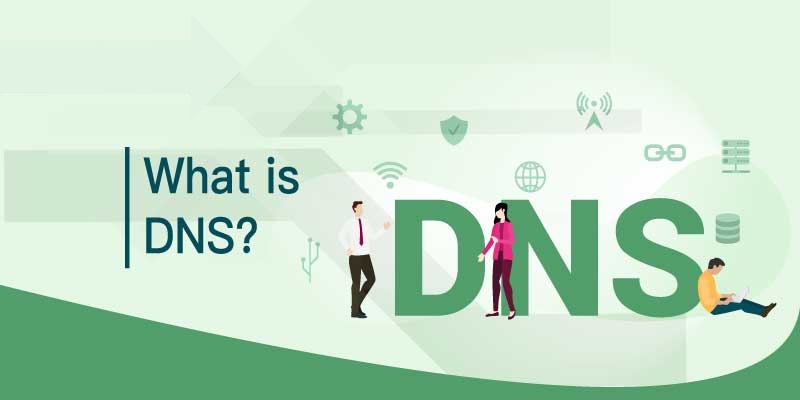Whenever you enter the domain name of any website, let us say https://www.amazon.com, into your browser’s address bar, you will get the desired website in your browser. But have you ever thought about how your browser displays the exact website for which you entered the domain name?
The browser interacts with a server regarding where to find the website, and this server is called a DNS Server. DNS servers are special servers that are only used to respond to questions about the domain name system (DNS). You may now be wondering what the DNS, or domain name system, actually is. Let us understand the term briefly before moving to the DNS server.
Domain Name System (DNS) is analogous to the phonebook or address book, where we search for the names, addresses, and phone numbers of people in specific geographical areas.
We can think of DNS as a phonebook of the internet. Domain names and their related IP addresses make up DNS. To have an idea of an IP address is a string of numbers assigned to every device on the internet so that it can be uniquely identified.
However, it is pretty challenging to remember the sequence of numbers (an IP address) to visit a specific website. Entering the domain name is way easier. But the issue is the computer system does not understand human-readable domain names. This is where the role of a DNS server comes into play. It translates the domain names into their corresponding numeric IP addresses so that computer systems can understand them.
In this blog post, we shall make you familiar with what exactly the DNS server is and how it works.
What is a DNS Server?
A Domain Name System (DNS) server is in charge of converting the domain name you enter in your browser’s address bar into an equivalent numeric IP address that leads you to the correct website.
Let us say you enter the domain name in your browser’s URL bar, https://www.www.example.com. Whenever you enter this domain name, your browser connects with the DNS server that converts the domain name you enter into an equivalent IP address, something like this: 71.262.161.720.
Isn’t it difficult to remember the above IP address? It is, right? So, the DNS server eliminates the need to enter the IP address in your browser’s search bar. Instead, you can simply use the domain name and still visit the desired website.
So, in simple terms, a DNS server is a machine that answers all your queries associated with DNS.
How Does a DNS Server Work?
Now that you know what exactly the DNS server does. Let us now discuss how the DNS server provides you with the desired website in your browser.
When you type the domain name in the browser’s address bar, the DNS server immediately works to find the address of the website that you are looking for. It sends a DNS query to multiple servers, where each server works on translating the different parts of the domain name you provided.
The following are the different servers involved in processing the DNS query:
- DNS Resolver: Upon receiving the DNS query from the DNS client, the DNS resolver, also known as DNS recursor, communicates with various other servers to find the IP address. Now, the resolver itself acts as a client. After it acts as a client, it requests three other DNS servers: the Root server, TLD server, and the Authoritative Name Server.
- Root Server: This is the first step where the process of converting the domain name into the IP address begins. After it receives the DNS query, it returns the result to the DNS resolver that assists in knowing what address of the TLD server keeps the information of the website you wish to visit.
- TLD Server: Later, the DNS resolver queries the TLD (Top Level Domain) server and returns the Authoritative Name Server to which the requested website is returned.
- Authoritative Name Server: The DNS resolver, lastly, makes a query to the authoritative name server to determine the website's actual IP address.
When the DNS server receives the IP address, it then displays the website in your browser. Though it seems a lengthy process, it takes place at lightning speed.
The most important thing to note here is that the aforementioned process takes place only the first time you visit the website. When you visit the same website later, there is no need for this entire process until you clear the browser’s cache.
DNS Server Not Responding
Many times, when you try to visit a specific website by entering its domain name, you get a message on the screen “DNS Server Isn’t Responding.” It implies that the DNS server failed to respond to the request.
There are a few explanations as to why the DNS server is not able to respond to user requests. They are as follows:
- An unstable or weak internet connection that makes it difficult for your browser to connect with the DNS server.
- There is a need to update your DNS setting or browser.
- Issues at the DNS server, such as the power loss at the data center that houses the DNS server.
Conclusion
That was all about the DNS server and its working. Perhaps now that you've read this blog post, you might have gained enough clarity on how important DNS servers are. Without the DNS server, you would have to remember the actual numeric IP addresses to access any website on the internet. DNS servers have simplified this task by allowing us to simply use human-readable domain names and visit the desired website.


No comments yet